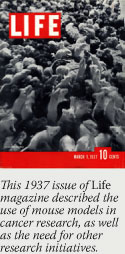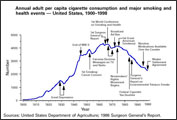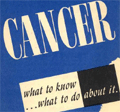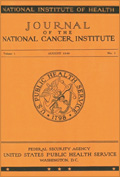To help commemorate NCI's 70th Anniversary, the following historical notes are being featured in each issue of the
NCI Cancer Bulletin:
In the decade after the National Cancer Institute Act was passed in 1937, Public Health Service laws were rewritten to include more authority for research, grants, and training at NIH, as well as a clinical center. Subsequently, half a dozen new institutes were developed for other categories of health research, each in the model of NCI, thus pluralizing NIH. (NCI Cancer Bulletin, Dec. 18, 2007)

NIH had two personnel systems when NCI was created: the Commissioned Corps of the Public Health Service and the Federal Civil Service. Most of the NCI scientific staff were in the Federal Civil Service, as were research fellows, though a few of the physicians chose to enter the Commissioned Corps. (NCI Cancer Bulletin, Dec. 4, 2007)

The earliest NCI cancer epidemiology studies in the late 1930s and early 1940s focused on two activities: a survey of radiation protection in hospitals and an evaluation of breast cancer therapy based on records from nine large cancer hospitals. According to a 1977 article in the Journal of the National Cancer Institute by Dr. Michael Shimkin, one of the first NCI research fellows who eventually rose through the ranks of its leadership, "The prevailing view was that, until cancer prevention became practical on a public health scale, the control of the disease was dependent on cancer therapy." (NCI Cancer Bulletin, Nov. 6, 2007)

After NCI began funding research proposals in 1937, there was a strict policy of separation between intramural and extramural projects. This was, in part, to avoid criticism that intramural personnel could benefit from knowledge of extramural grant requests. However, with the advent of a contract mechanism to support research in the 1950s, intramural scientists were required to serve as project officers for extramural research funded by NCI. (NCI Cancer Bulletin, Oct. 23, 2007)

Early on, some members of the National Advisory Cancer Council had reservations about placing NCI within the administrative structure of the Public Health Service (PHS); they thought that the Veterans Administration was a better fit. But U.S. Surgeon General Thomas Parran prevailed in his choice of the PHS partly because two cancer-focused research programs already existed within this governance: a group in Boston and another in Washington, DC. (NCI Cancer Bulletin, Oct. 9, 2007)

In 1937, little was known about the origins of cancer. Some doubted that the cause of the disease would ever be understood and discouraged investment in this research. But scientists already understood that environmental exposures could cause tumors and that there may be a genetic component to certain types of cancer. (NCI Cancer Bulletin, Sept. 25, 2007)

When the United States entered World War II, many laboratory and animal technicians enlisted or were drafted into the Armed Forces. Many of these technicians had originally obtained their jobs through the Works Progress Administration. After the war, many used the G.I. Bill of Rights to further their education, going on to become physicians or other medical professionals. (NCI Cancer Bulletin, Sept. 11, 2007)

 Several months before the National Cancer Institute Act was passed by Congress and signed by President Roosevelt, Fortune magazine had published an article, "Cancer: the Great Darkness," that pointed out the small amount of money that was being spent for cancer research.
Several months before the National Cancer Institute Act was passed by Congress and signed by President Roosevelt, Fortune magazine had published an article, "Cancer: the Great Darkness," that pointed out the small amount of money that was being spent for cancer research. This article, as well as ones that appeared in
Life and
Time magazines, was purportedly stimulated by a meeting held by the Medical Section of the American Academy for the Advancement of Science in Atlantic City, December 1936. As a result of these articles, members of Congress began to receive many letters from the public, urging them to do something about cancer. (
NCI Cancer Bulletin, Aug. 21, 2007)

 The National Advisory Cancer Council sponsored its first conference in 1937 to provide administrators and directors of cancer research institutions input on the development of activities proposed under the National Cancer Institute Act.
The National Advisory Cancer Council sponsored its first conference in 1937 to provide administrators and directors of cancer research institutions input on the development of activities proposed under the National Cancer Institute Act. In 1940, the Council sponsored its first scientific conference to discuss gastric cancer and encourage gastric cancer research. (
NCI Cancer Bulletin, Aug. 7, 2007)

 The link between smoking and cancer was first noted in scientific literature in the 1930s,
The link between smoking and cancer was first noted in scientific literature in the 1930s, at a time when the smoking prevalence in the United States was rising, particularly among soldiers who received cigarette rations during World War I. The first large epidemiological study proving this link, however, wasn't published until 1950. (
NCI Cancer Bulletin, July 24, 2007)

 During its first 2 years, NCI established research fellowships to train cancer researchers from many different fields.
During its first 2 years, NCI established research fellowships to train cancer researchers from many different fields. By 1943, 40 people had completed these research fellowships. (
NCI Cancer Bulletin, July 10, 2007)

 An important part of the National Cancer Institute Act was the authorization to design a program that would increase physicians' abilities to diagnose and treat cancer.
An important part of the National Cancer Institute Act was the authorization to design a program that would increase physicians' abilities to diagnose and treat cancer. It provided "traineeships" to young doctors who had graduated from medical school and completed 1-year internships, and who pledged to devote themselves to the specialty of diagnosing and treating cancer. These trainees made $6 a day, then the going rate, and by the summer of 1938, there were 14 doctors enrolled in the program. (
NCI Cancer Bulletin, June 26, 2007)

 With the encouragement of NCI representatives, in 1939, seven U.S. states began to include cancer control in their health departments' missions; three states established cancer commissions.
With the encouragement of NCI representatives, in 1939, seven U.S. states began to include cancer control in their health departments' missions; three states established cancer commissions. NCI also began to distribute information on cancer for public education, and produced a movie for this purpose with the help of the American Society for Control of Cancer that was designed for nonscientific viewers. Eventually, the Institute published "What to Know, What to Do about Cancer" - a prelude to NCI's "What You Need to Know About…" series - and distributed 48,000 copies for free. (
NCI Cancer Bulletin, June 12, 2007)

 In the 1930s, surgery, radiation, and x-rays were the only treatments available for cancer.
In the 1930s, surgery, radiation, and x-rays were the only treatments available for cancer. In its earliest years, NCI began distributing radium to about 70 hospitals throughout the country for the treatment of financially disadvantaged patients. This program lasted through the late 1960s and was favored by Congress because it brought immediate benefits to the American public. (
NCI Cancer Bulletin, May 29, 2007)
 The year before the National Cancer Institute Act of 1937, Marjorie G. Illig of the American Society for the Control of Cancer (predecessor of the American Cancer Society) suggested the creation of a legion of female volunteers.
The year before the National Cancer Institute Act of 1937, Marjorie G. Illig of the American Society for the Control of Cancer (predecessor of the American Cancer Society) suggested the creation of a legion of female volunteers. The goal of the Women's Field Army was to raise money for cancer research and to educate the public about cancer. Her recruits wore khaki uniforms with insignia for rank and achievement. In less than 3 years, they helped increase the number of volunteers who were active in cancer control by tenfold. (
NCI Cancer Bulletin, May 15, 2007)

Before NCI was founded, the government had published a few reports on mortality from cancer, including a report using Census records leading up to the year 1914 and a second volume on cancer mortality from 1900-1920. Dr. Joseph Schereschewsky, who published the 1925 report on cancer mortality from 1900-1920, was an early pioneer in such statistical studies on cancer and his work established cancer research as a priority for the Public Health Service (PHS). "It would be of immense value to students of public health problems if the government could publish another volume...in the light of our increased knowledge concerning the nature of cancer," wrote an expert panel convened by the U.S. Surgeon General in 1928 to advise the PHS in developing its cancer research program. (NCI Cancer Bulletin, May 1, 2007)
 The first issue of the Journal of the National Cancer Institute was published in August of 1940.
The first issue of the Journal of the National Cancer Institute was published in August of 1940. The journal's Editor in Chief was NCI's Director Dr. Carl Voegtlin. The first few volumes of the journal featured articles on stomach cancer, a predominant cancer of the era, and mostly contained papers written by NCI staff members. (
NCI Cancer Bulletin, Apr. 17, 2007)
 In 1927 - a decade before NCI was established to stimulate cancer research - Senator M. M. Neely of West Virginia proposed a bill that would offer a $5 million reward for the discovery of a cure for cancer.
In 1927 - a decade before NCI was established to stimulate cancer research - Senator M. M. Neely of West Virginia proposed a bill that would offer a $5 million reward for the discovery of a cure for cancer. Senator Neely's "reward" bill did not pass, but it was among the first in a series of proposed legislation that laid the groundwork for the 1937 National Cancer Institute Act. (
NCI Cancer Bulletin, Apr. 3, 2007)
 Among the first clinical cancer research centers supported by NCI was the United States Marine Hospital in Baltimore.
Among the first clinical cancer research centers supported by NCI was the United States Marine Hospital in Baltimore. Funded in 1939, the center was designated to provide expert cancer care for patients east of the Mississippi River. (
NCI Cancer Bulletin, Mar. 27, 2007)
 NCI's first director was Dr. Carl Voegtlin, who served in this role from 1938 to 1943.
NCI's first director was Dr. Carl Voegtlin, who served in this role from 1938 to 1943. He was born in Switzerland and received his Ph.D. from the University of Frieberg before coming to the United States in 1905. Dr. Voegtlin worked as a chemistry instructor at the University of Wisconsin, then at Johns Hopkins University, before joining the U.S. Public Health Service in 1913 and becoming the chief of the Division of Pharmacy at the Hygienic Laboratory, a predecessor to the NIH. (
NCI Cancer Bulletin, Mar. 20, 2007)
 In their 1938 deliberations over NCI's expenditures, the National Advisory Cancer Council considered purchasing 15 to 20 grams of radium for research on treating cancer with radiation.
In their 1938 deliberations over NCI's expenditures, the National Advisory Cancer Council considered purchasing 15 to 20 grams of radium for research on treating cancer with radiation. However, they decided against such a large amount of radium, expecting that a supervoltage x-ray machine would soon be available for the same purpose. (
NCI Cancer Bulletin, Mar. 6, 2007)
The first staff at NCI was comprised of Harvard personnel, most of whom had been working in the laboratory of Dr. Joseph Schereschewsky in Cambridge, MA, which was later led by Dr. Carl Voegtlin (the first Chief of NCI) after Dr. Schereschewsky's retirement. Both Dr. Schereschewsky and Dr. Voegtlin were commissioned officers of the Public Health Service. (NCI Cancer Bulletin, Feb. 27, 2007)
In November 1937, NCI awarded its first research grants, which totaled $90,925 by the end of that fiscal year. The first recipients were Dr. Louis F. Fieser of Harvard - $27,550 to study chemical structures and carcinogenesis; Dr. E. O. Lawrence of the University of California, Berkeley - $30,000 to study the development of a cyclotron for cancer therapy; and Dr. Edward Wallace of the University of Cincinnati - $1,500 for the study of the pituitary gland and cancer. (NCI Cancer Bulletin, Feb. 20, 2007)
NCI's budget in 1938 was $400,000, with $200,000 designated by Congress for the purchase of radium. Within 10 years, the budget increased to $42 million. (NCI Cancer Bulletin, Feb. 14, 2007)
 The first advisory group involved with NCI's leadership was the National Advisory Cancer Council
The first advisory group involved with NCI's leadership was the National Advisory Cancer Council, which included Dr. James Ewing of Memorial Hospital in New York, Dr. C.C. Little of the American Society for the Control of Cancer, Dr. Francis Carter Wood of Columbia University, Dr. Ludvig Hektoen of the Institute of Medicine in Chicago, Dr. Arthur Compton of the University of Chicago, and Dr. James B. Conant of Harvard University. Dr. Thomas Parran, then the U.S. Surgeon General, was a member
ex officio and the council's first chairman. (
NCI Cancer Bulletin, Feb. 6, 2007)
 The NIH campus was erected in Bethesda, MD, on 45 acres of land that had been donated to the government by Mr. and Mrs. Luke Wilson.
The NIH campus was erected in Bethesda, MD, on 45 acres of land that had been donated to the government by Mr. and Mrs. Luke Wilson. Upon passage of the National Cancer Institute Act in 1937, Mrs. Wilson, whose husband had died of cancer, donated an additional 10 acres for the construction of NCI's first building, Building 6, the cornerstone of which was laid on June 24, 1939. (
NCI Cancer Bulletin, Jan. 30, 2007)
 On August 5, 1937, President Franklin D. Roosevelt signed legislation that established NCI to support research related to the causes, diagnosis, and treatment of cancer.
On August 5, 1937, President Franklin D. Roosevelt signed legislation that established NCI to support research related to the causes, diagnosis, and treatment of cancer. The legislation was a result of four bills introduced in Congress, the first by Senator Homer T. Bone of Washington State, the second by Congressman Warren G. Magnuson of Washington State, the third by Congressman Maury Maverick of Texas (with significant contributions made by Dr. Dudley Jackson of San Antonio), and the fourth by Congressman John F. Hunter of Ohio. The four bills were all very similar, differing only in their proposed funding schedule for the national cancer program and the proposed name of the center that would lead it. Senate and House cancer research subcommittees held a joint hearing for all four bills on July 8, 1937. The legislation was revised and passed by Congress on July 23 of that year. (
NCI Cancer Bulletin, Jan. 23, 2007)